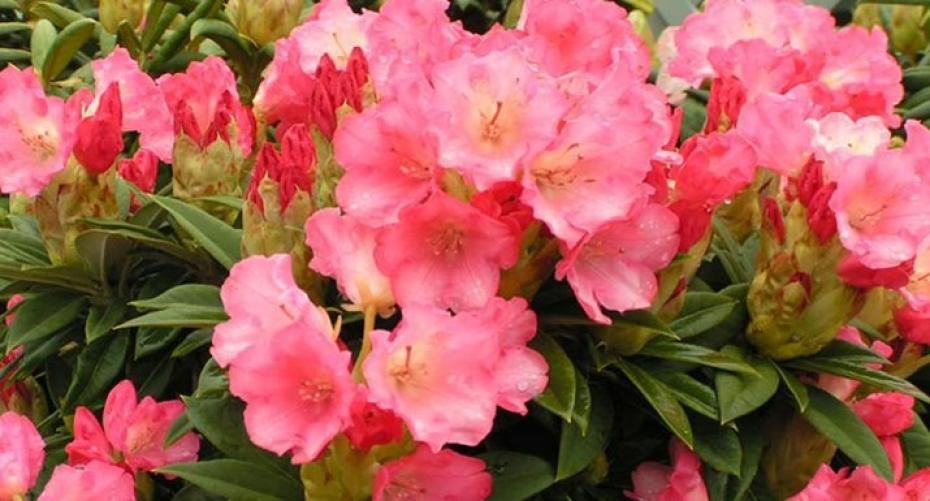Rhododendron 'Surrey Heath'
Plant azaleas, rhododendrons and camellias for a superb spring display
Planting
- They all need an acid soil so you need to do a pH test to make sure your soil is suitable.
- If your soil is alkaline it would be better to grow them in a container, or choose one of the lime tolerant rhododendrons.
- Dig a hole slightly larger than the pot it is already in and add some good quality ericaceous compost.
- Tease out the roots so they have a good start to reach out into the compost.
- Plant to the same depth as it is in the pot. Rhododendrons and azaleas are shallow rooted so don't plant too deeply.
- Replace the compost and firm in.
- Water well after planting and mulch with 5cm (2”) ericaceous compost or chipped pine bark.
- If planting in a container make sure there are plenty of drainage holes in the bottom, cover them with a piece of crock to ensure they don’t become blocked with silt. Choose a container about 3 times the size of the pot it is already in. Plant in good quality ericaceous compost.

Azalea 'Madame Galle'
Aftercare
- Make sure they are kept damp, after all they come from cool, damp mountain regions of Asia.
- When planting in the ground water them regularly for the first 18 months at least, and thereafter if there are any dry spells.
- If they are in a container move it to a shady spot if it is a hot dry summer and you may have to water twice a day.
- Re-pot every 2 years if growing in a container as the soil can become compacted and waterlogged.
- If planting them on a slope, make a small dam with soil on the downward side to retain the water, otherwise the water will just run straight past the plant without penetrating the soil.
- Feed after flowering with a dedicated rhododendron, azalea and camellia fertiliser.
- Water well and mulch with ericaceous compost or chipped pine bark after feeding.
- There is no need to prune; if they are becoming too large for the space take out a third of the branches over 3 consecutive years.
- Take off spent flowers but be careful not to remove the growing point which will produce next years flower.
- Take out any dead and diseased branches.
- Don't hoe around the roots as they are quite near the surface and are easily damaged.

Species Rhododendron falconerii
Problems
- Yellow leaves are usually a sign that the plant is suffering from a nutrient deficiency so feed in spring after flowering with a specialised fertiliser for rhododendrons, azaleas and camellias. Mulch after feeding with ericaceous compost or composted pine bark to maintain the acidity.
- Yellow leaves could also be caused by planting in an alkaline soil so do a pH test and if the soil has a pH of above 5.5 then dig the plant out and grow it in a container.
- If the plant is in a container and the leaves start to yellow and drop the compost could have become exhausted so take the plant out and remove as much compost as possible from around the roots, then replant into fresh compost.
- If buds form but then drop the plant is stressed and short of moisture so make sure it is kept permanently damp; they are particularly prone to drying out in the summer months.
- No flowers in spring are usually caused by a lack of food and water the previous summer. Lack of flowers can also be caused by taking off the growing point when deadheading the previous spring.
- A black deposit on the leaves is caused by sooty fungus which grows on the secretions of scale insects, so you also need to tackle the insect problem. If the sooty fungus is particularly bad you may have to prune out the worst infected branches. Try and wash off the sooty fungus, as when you spray with a systemic insecticide to tackle the scale insects it may not be able to penetrate through to the surface of the leaf. Spray the fungus with a fungicide.
- Scale insects are tiny flat discs which are usually found on the underside of the leaves. One of the first signs that you have a problem is a sticky residue on the leaves which will quickly become infected with sooty fungus. Tackle the sooty fungus then spray with a systemic insecticide.
- Honey fungus attacks the roots and often the first signs are die back of the plant. Check for the fungus by peeling back the bark at the base of the trunk and if there is a white fungal layer then the plant is infected. The fungus manifests itself above ground in autumn by the presence of clumps of honey-coloured toadstools. It’s not treatable so the plant must be dug up and burned; don’t put it on the compost heap. When re-planting opt for plants which are not susceptible to the fungus.

Camellia 'R L Wheeler'
Varieties
- If planting in a container go for the smaller evergreen azaleas or the yakushimanum rhododendrons. Deciduous azaleas can be grown in a container but they will have a limited lifespan as they can reach 9m (30’) grown in the ground.
- They are a woodland plant so would particularly suit a woodland garden, but make sure they are not too shaded otherwise they will produce fewer flowers.
- Avoid the species rhododendron if you have restricted space as they usually grow into large shrubs.
- Some of the deciduous azaleas have a delicious scent; particularly the yellow flowered Rhododendron luteum which grows to a height of 4.5m (15m).
For more information, hints and tips on making the most of your garden just get in touch with our Outdoor Plant team here in store.




![Kingsbury-bench-05[1].jpg](http://www.hayesgardenworld.co.uk/cdn/shop/files/Kingsbury-bench-05_5B1_5D.jpg?v=1712162737&width=1500)
![Kingsbury-bench-01[1].jpg](http://www.hayesgardenworld.co.uk/cdn/shop/files/Kingsbury-bench-01_5B1_5D.jpg?v=1712161065&width=1500)
![tw17a-4947_0[1].jpg](http://www.hayesgardenworld.co.uk/cdn/shop/files/tw17a-4947_0_5B1_5D.jpg?v=1712161495&width=1500)
![tw17a-4947_tenbury_5ft[1].jpg](http://www.hayesgardenworld.co.uk/cdn/shop/files/tw17a-4947_tenbury_5ft_5B1_5D.jpg?v=1712161172&width=1500)
![tw17a-4952_tenbury_4ft[1].jpg](http://www.hayesgardenworld.co.uk/cdn/shop/files/tw17a-4952_tenbury_4ft_5B1_5D.jpg?v=1712161034&width=1500)
![thumbnail_IMG_1565-kik_2[1].jpg](http://www.hayesgardenworld.co.uk/cdn/shop/files/thumbnail_IMG_1565-kik_2_5B1_5D.jpg?v=1712226536&width=1500)
![thumbnail_IMG_1565-kik_1[3].jpg](http://www.hayesgardenworld.co.uk/cdn/shop/files/thumbnail_IMG_1565-kik_1_5B3_5D.jpg?v=1712159637&width=1500)



![WD-XgESA[1].jpeg](http://www.hayesgardenworld.co.uk/cdn/shop/files/WD-XgESA_5B1_5D.jpg?v=1712159609&width=1500)